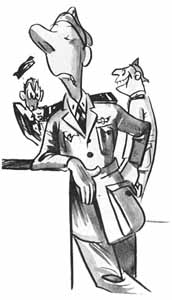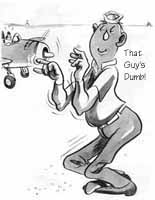|
It seems that every aviator goes through a period early in his career, somewhere
between 300 and 800 hours of flight time, where he knows everything and can't be taught
anymore - or at least so he thinks. With the great expansion of air forces required by
America's entry into World War II, this phenomenon reared its ugly head especially in the
U.S. Navy, where operational accidents by newly trained aviatiors seemed to skyrocket.

 |
The cartoon character originally named "Dilbert Groundloop" was conceived by
Capt. Austin Doyle, USN and Lt. Cdr. Robert Osborn, USNR in the weeks after Pearl Harbour,
with Osborn being the artist. The name was quickly shortened to just "Dilbert"
and in a series of one panel sketches on flyers and in training pamphlets, Dilbert quickly
became a sort of anti-hero as the classic head-up-and-locked pilot just looking for an
accident. |
| Older experienced aviators knew to avoid the brightly colored primary and basic
trainers, but it was hard to know what a "700-hour stage" pilot might do, such
as Dilbert. |
 |
 |
The classic "kick-the-tires and light-the-fires", too hurried to worry about
a preflight inspection sort of accident seemed a normal event for Dilbert. |
| Although Dilbert represented the worst of commissioned aviators, his
"cousin", Spoiler, helped teach enlisted ground crewmen how not to foul up, too.
Here, Spoiler's indestinct marshalling signals are no help to the pilot. |
 |
|